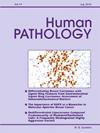Hepatic adenomas in males: Is molecular characterization helpful in guiding its management?
IF 2.6
2区 医学
Q2 PATHOLOGY
引用次数: 0
Abstract
Background and aims
Hepatocellular adenomas (HCAs) in males are very rare. We performed detailed clinicopathologic, immunohistochemical and molecular characterization of HCAs in males, to understand their pathogenesis and malignant potential.
Methods
Seven cases of HCA in males formed our study cohort. The histologic slides, clinical and follow-up information were reviewed and immunohistochemical stains were performed. DNA was extracted and targeted sequencing was performed using Ion Torrent chemistry. Filtered variants were annotated to identify pathogenic mutations.
Results
Six (86 %) patients were morbidly obese. All showed at least focal cytologic atypia. Three lesions were markedly steatotic and 2 were hemorrhagic. One lesion showed focal reticulin loss, diffuse glutamine synthetase (GS) positivity and beta-catenin (β-catenin) nuclear staining, suggestive of atypical hepatocellular neoplasm. Three (42.8 %) cases were inflammatory-type, showing diffuse serum amyloid-associated protein/C-reactive protein. One other inflammatory-type HCA showed peripheral accentuation with GS and another non-inflammatory HCA showed patchy staining with GS; both revealed CTNBB1 mutations but no β-catenin nuclear staining. None showed TP53, TERT promotor mutations, or significant copy number alterations.
Conclusion
A significant proportion of HCAs in males occurred in obese patients and were inflammatory-type. While some are beta-catenin mutated and need to be resected, a subset of HCAs in males appears to be low-risk by molecular features and may be treated conservatively.
男性肝腺瘤:分子特征是否有助于指导其治疗?
背景与目的男性肝细胞腺瘤(hca)非常罕见。我们对男性HCAs进行了详细的临床病理、免疫组织化学和分子表征,以了解其发病机制和恶性潜能。方法选取7例男性HCA患者作为研究对象。回顾了组织学切片、临床和随访资料,并进行了免疫组织化学染色。提取DNA,利用离子激流化学进行靶向测序。对过滤后的变异进行注释,以确定致病突变。结果6例(86%)患者为病态肥胖。所有患者均至少表现为局灶性细胞学异型。3个病变明显脂肪变性,2个出血。一个病灶显示局灶性网状蛋白丢失,弥漫性谷氨酰胺合成酶(GS)阳性,β-连环蛋白(β-连环蛋白)核染色,提示非典型肝细胞肿瘤。3例(42.8%)为炎症型,表现为弥漫性血清淀粉样蛋白/ c反应蛋白。另一种炎症型HCA表现为GS外周强化,另一种非炎症型HCA表现为GS斑状染色;均显示CTNBB1突变,但未见β-连环蛋白核染色。没有发现TP53、TERT启动子突变或显著的拷贝数改变。结论男性hca主要发生在肥胖患者中,且为炎症型。虽然有些是β -连环蛋白突变,需要切除,但从分子特征来看,男性hca的一部分似乎是低风险的,可以保守治疗。
本文章由计算机程序翻译,如有差异,请以英文原文为准。
求助全文
约1分钟内获得全文
求助全文
来源期刊

Human pathology
医学-病理学
CiteScore
5.30
自引率
6.10%
发文量
206
审稿时长
21 days
期刊介绍:
Human Pathology is designed to bring information of clinicopathologic significance to human disease to the laboratory and clinical physician. It presents information drawn from morphologic and clinical laboratory studies with direct relevance to the understanding of human diseases. Papers published concern morphologic and clinicopathologic observations, reviews of diseases, analyses of problems in pathology, significant collections of case material and advances in concepts or techniques of value in the analysis and diagnosis of disease. Theoretical and experimental pathology and molecular biology pertinent to human disease are included. This critical journal is well illustrated with exceptional reproductions of photomicrographs and microscopic anatomy.
 求助内容:
求助内容: 应助结果提醒方式:
应助结果提醒方式:


